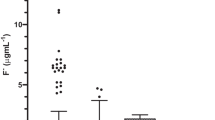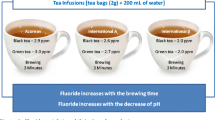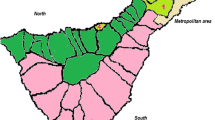Abstract
Purpose
Fluoride level, due to its narrow therapeutical range, must be constantly monitored in beverages, especially in daily-consumed plant infusions. Fluoride is important for prevention of tooth decay and osteoporosis, but its excess leads to fluorosis. Since tea can selectively absorb fluorides from soils, the question arises if a long-term consumption can pose an adverse effect on human health.
Methods
Infusions of 33 popular teas (black, green, white, earl grey, pu-erh), tea-like products (rooibos, yerba mate) and herbs (chamomile, mint, nettle, purges, yarrow) available in the Polish market were analyzed with respect to a fluoride level by means of a validated ion-selective electrode method, which is proven to be fast and reliable.
Results
Significantly different fluoride concentrations in infusions were observed, with black tea on top, where extraction of fluoride is the highest (average 2.65 mg F−/L, range 0.718–6.029 mg/L). Two-fold higher fluoride contents were measured in infusions made from black tea bags than from leaves (average 3.398 mg/L and 1.529 mg/L, respectively). Green teas released comparable amounts of fluoride as black teas, while in herbal extracts the fluoride content was negligible.
Conclusions
The rank with respect to the fluoride concentration in an infusion is as follows: black tea > green tea > earl grey > pu-erh > white tea>>>rooibos, yerba mate, herbal products. Increasing of brewing time results in an increased fluoride content, but the overall content of fluoride in the analyzed infusions of teas and herbs was not high enough to cause a risk of fluorosis, even if left to brew up to 15 min.





Similar content being viewed by others
References
Zhang M, Wang A, Xia T, He P. Effects of fluoride on DNA damage, S-phase cell-cycle arrest and the expression of NF-kappaB in primary cultured rat hippocampal neurons. Toxicol Lett. 2008;179:1–5.
Tokalioglu S, Kartal S, Şahin U. Determination of fluoride in various samples and some infusions using a fluoride selective electrode. Turk J Chem. 2004;28:203–11.
WHO. Guidelines for drinking-water quality, 4th edition, incorporating the 1st addendum 2017. World Health Organization. Geneva. [Internet]. [cited 2021 Apr 29]. Available from: https://www.who.int/publications-detail-redirect/9789241549950.
Yousefi M, Kazemi Moghaddam V, Nasab S, Nabizadeh R, Hadei M, Zarei A, et al. Northwest of Iran as an endemic area in terms of fluoride contamination: a case study on the correlation of fluoride concentration with physicochemical characteristics of groundwater sources in Showt. Desalination Water Treat. 2019;155:183–9.
Mohammadi AA, Yousefi M, Mahvi AH. Fluoride concentration level in rural area in Poldasht city and daily fluoride intake based on drinking water consumption with temperature. Data Brief. 2017;13:312–5.
Yousefi M, Ghalehaskar S, Asghari FB, Ghaderpoury A, Dehghani MH, Ghaderpoori M, et al. Distribution of fluoride contamination in drinking water resources and health risk assessment using geographic information system, northwest Iran. Regul Toxicol Pharmacol. 2019;107:104408.
Mirzabeygi (Rad Fard), Yousefi M, Soleimani M, Mohammadi H, Mahvi AA, Abbasnia AH. The concentration data of fluoride and health risk assessment in drinking water in the Ardakan city of Yazd province, Iran. Data Brief. 2018;18:40–6.
Bhatnagar A, Kumar E, Sillanpää M. Fluoride removal from water by adsorption—A review. Chem Eng J. 2011;171:811–40.
Vinati A, Mahanty B, Behera SK. Clay and clay minerals for fluoride removal from water: A state-of-the-art review. Appl Clay Sci. 2015;114:340–8.
Pehrsson PR, Patterson KY, Perry CR. The fluoride content of select brewed and microwave-brewed black teas in the United States. J Food Compos Anal. 2011;24:971–5.
Malin AJ, Till C. Exposure to fluoridated water and attention deficit hyperactivity disorder prevalence among children and adolescents in the United States: an ecological association. Environ Health. 2015;14:17.
Opydo-Szymaczek J, Opydo J. Fluoride content of beverages intended for infants and young children in Poland. Food Chem Toxicol. 2010;48:2702–6.
Yi J, Cao J. Tea and fluorosis. J Fluorine Chem. 2008;129:76–81.
Cao J, Zhao Y, Liu J, Xirao R, Danzeng S, Daji D, et al. Brick tea fluoride as a main source of adult fluorosis. Food Chem Toxicol. 2003;41:535–42.
Yousefi M, Yaseri M, Nabizadeh R, Hooshmand E, Jalilzadeh M, Mahvi AH, et al. Association of Hypertension, Body Mass Index, and Waist Circumference with Fluoride Intake; Water Drinking in Residents of Fluoride Endemic Areas, Iran. Biol Trace Elem Res. 2018;185:282–8.
Yousefi M, Mohammadi AA, Yaseri M, Mahvi AH. Epidemiology of drinking water fluoride. and its contribution to fertility, infertility, and abortion: an ecological study in West Azerbaijan Province, Poldasht County, Iran. Fluoride. 2017;50(3)343–53.
Moghaddam VK, Yousefi M, Khosravi A, Yaseri M, Mahvi AH, Hadei M, et al. High concentration of fluoride can be increased risk of abortion. Biol Trace Elem Res. 2018;185:262–5.
Karak T, Bhagat RM. Trace elements in tea leaves, made tea and tea infusion: A review. Food Res Int. 2010;43:2234–52.
Giljanović J, Prkić A, Bralić M, Brkljača M. Determination of fluoride content in tea infusion by using fluoride ion-selective electrode. Int J Electrochem Sci. 2012;2918–27.
Wong MH, Fung KF, Carr HP. Aluminium and fluoride contents of tea, with emphasis on brick tea and their health implications. Toxicol Lett. 2003;137:111–20.
Chen L, ShangGuan L, Wu Y, Xu L, Fu F. Study on the residue and degradation of fluorine-containing pesticides in Oolong tea by using gas chromatography–mass spectrometry. Food Control. 2012;25:433–40.
Cai H, Zhu X, Peng C, Xu W, Li D, Wang Y, et al. Critical factors determining fluoride concentration in tea leaves produced from Anhui province, China. Ecotoxicol Environ Saf. 2016;131:14–21.
Gao H, Zhao Q, Zhang X, Wan X, Mao J. Localization of fluoride and aluminum in subcellular fractions of tea leaves and roots. J Agric Food Chem. 2014;62(10):2313–9.
Karami MA, Fakhri Y, Rezania S, Alinejad AA, Mohammadi AA, Yousefi M, et al. Non-carcinogenic health risk assessment due to fluoride exposure from tea consumption in Iran using Monte Carlo simulation. Int J Environ Res Public Health. Multidisciplinary Digital Publishing Institute; 2019;16:4261.
Fung KF, Zhang ZQ, Wong JWC, Wong MH. Fluoride contents in tea and soil from tea plantations and the release of fluoride into tea liquor during infusion. Environ Pollut. 1999;104:197–205.
Cao H. Polysaccharides from Chinese tea: recent advance on bioactivity and function. Int J Biol Macromol. 2013;62:76–9.
IGG TEA.23 | Food and Agriculture Organization of the United. Nations 17–20 May 2018, Hangzhou, China [Internet]. [cited 2021 May 6]. Available from: http://www.fao.org/ccp/tea23/en/.
Yearbook Trade of Foreign Statistics of Poland., Statistics Poland; Warsaw, 2020, pp.278. ISSN 0079–2691.
Chung F-L, Schwartz J, Herzog C, Yang Y-M. Tea and cancer prevention: studies in animals and humans. J Nutr. 2003;133:3268S-3274S.
Chen G, Yuan Q, Saeeduddin M, Ou S, Zeng X, Ye H. Recent advances in tea polysaccharides: Extraction, purification, physicochemical characterization and bioactivities. Carbohydr Polym. 2016;153:663–78.
Sofuoglu SC, Kavcar P. An exposure and risk assessment for fluoride and trace metals in black tea. J Hazard Mater. 2008;158:392–400.
Zhang L, Zhang J, Chen L, Liu T, Ma G, Liu X. Influence of manufacturing process on the contents of iron, copper, chromium, nickel and manganese elements in Crush, Tear and Curl black tea, their transfer rates and health risk assessment. Food Control. 2018;89:241–9.
Schulzki G, Nüßlein B, Sievers H. Transition rates of selected metals determined in various types of teas (Camellia sinensis L. Kuntze) and herbal/fruit infusions. Food Chem. 2017;215:22–30.
Mannani N, Tabarani A, Abdennebi EH, Zinedine A. Assessment of aflatoxin levels in herbal green tea available on the Moroccan market. Food Control. 2020;108:106882.
Yang Y, Peng C, Thompson HJ, Wang Y. Assuring that your cup of tea is risk-free. Curr Opin Food Sci. 2019;30:98–102.
Li X, Zhang Z, Li P, Zhang Q, Zhang W, Ding X. Determination for major chemical contaminants in tea (Camellia sinensis) matrices: A review. Food Res Int. 2013;53:649–58.
Canbay HS, Doğantürk M, Yilmaz Y. Acrylamide content of Turkish black tea, instant and Turkish coffee samples. Süleyman Demirel Üniversitesi Fen Bilimleri Enstitüsü Dergisi. 2019;23:245–50.
Cladière M, Delaporte G, Le Roux E, Camel V. Multi-class analysis for simultaneous determination of pesticides, mycotoxins, process-induced toxicants and packaging contaminants in tea. Food Chem. 2018;242:113–21.
Garcia Londoño VA, Reynoso CM, Resnik SL. Polycyclic aromatic hydrocarbons (PAHs) survey on tea (Camellia sinensis) commercialized in Argentina. Food Control. 2015;50:31–7.
Shao L, Xu S, Wang G, Yang L, Li R, Zhu J, et al. Fluoride in tea from Shandong Province, China and exposure assessment. Food Addit Contam Part B Surveill. 2020;13:77–81.
Krishnankutty N, Storgaard Jensen T, Kjær J, Jørgensen JS, Nielsen F, Grandjean P. Public-health risks from tea drinking: Fluoride exposure. Scand J Public Health. 2022;50(3):355–61.
Miri M, Bhatnagar A, Mahdavi Y, Basiri L, Nakhaei A, Khosravi R, et al. Probabilistic risk assessment of exposure to fluoride in most consumed brands of tea in the Middle East. Food Chem Toxicol. 2018;115:267–72.
Maleki A, Daraei H, Mohammadi E, Zand S, Teymouri P, Mahvi A, et al. Daily fluoride intake from Iranian Green Tea: Evaluation of various flavorings on fluoride release. Environ Health Insights. 2016;10:59–63.
Chan L, Mehra A, Saikat S, Lynch P. Human exposure assessment of fluoride from tea (Camellia sinensis L.): A UK based issue? Food Res Int. 2013;51:564–70.
Ruxton CHS, Bond TJ. Fluoride content of retail tea bags and estimates of daily fluoride consumption from typical tea drinking in UK adults and children. Nutr Bull. 2015;40:268–78.
Satou R, Oka S, Sugihara N. Risk assessment of fluoride daily intake from preference beverage. J Dent Sci. 2021;16:220–8.
Waugh DT, Godfrey M, Limeback H, Potter W. Black tea source, production, and consumption: assessment of health risks of fluoride intake in New Zealand. J Environ Public Health. 2017;2017:5120504.
Chandrajith R, Bhagya S, Diyabalanage S, Wimalasiri S, Ranatunga MAB, Barth JAC. Exposure assessment of fluoride intake through commercially available black tea (Camellia sinensis L.) from areas with high incidences of Chronic Kidney Disease with Undetermined Origin (CKDu) in Sri Lanka. Biol Trace Elem Res. 2022;200(2):526–34.
Waugh DT, Potter W, Limeback H, Godfrey M. Risk assessment of fluoride intake from tea in the republic of Ireland and its implications for public health and water fluoridation. Int J Environ Res Public Health. Multidisciplinary Digital Publishing Institute; 2016;13:259.
Koblar A, Tavčar G, Ponikvar-Svet M. Fluoride in teas of different types and forms and the exposure of humans to fluoride with tea and diet. Food Chem. 2012;130:286–90.
Kjellevold Malde M, Bjorvatn K, Julshamn K. Determination of fluoride in food by the use of alkali fusion and fluoride ion-selective electrode. Food Chem. 2001;73:373–9.
Cao J, Zhao Y, Li Y, Deng HJ, Yi J, Liu JW. Fluoride levels in various black tea commodities: Measurement and safety evaluation. Food Chem Toxicol. 2006;44:1131–7.
Das S, de Oliveira LM, da Silva E, Liu Y, Ma LQ. Fluoride concentrations in traditional and herbal teas: Health risk assessment. Environ Pollut. 2017;231:779–84.
Emekli-Alturfan E, Yarat A, Akyuz S. Fluoride levels in various black tea, herbal and fruit infusions consumed in Turkey. Food Chem Toxicol. 2009;47:1495–8.
Malinowska E, Inkielewicz I, Czarnowski W, Szefer P. Assessment of fluoride concentration and daily intake by human from tea and herbal infusions. Food Chem Toxicol. 2008;46:1055–61.
Esfehani M, Ghasemzadeh S, Mirzadeh M. Comparison of fluoride ion concentration in black, green and white tea. Int J Ayurvedic Med. 2018;9:263–5.
Mahvi AH, Zazoli MA, Younecian M, Esfandiari Y. Fluoride content of Iranian black tea and tea liquor. Fluoride. 2006;39(4):266–8.
Kłódka D, Telesiński A, Bońkowski M. Estimating the dependence between the content of fluorine and of selectived vitamins in different kinds of tea infusions. Bromatol Chem Toksykol. 2008;XLI:957–63 (in Polish).
Lv H-P, Lin Z, Tan J-F, Guo L. Contents of fluoride, lead, copper, chromium, arsenic and cadmium in Chinese Pu-erh tea. Food Res Int. 2013;53:938–44.
Rajković MB, Novaković ID. Determination of fluoride content in drinking water and tea infusions using fluoride ion selective electrode. J Agric Sci Belgrade. 2007;52:155–68.
Li H, Liu Q, Wang W, Yang L, Li Y, Feng F, et al. Fluoride in drinking water, brick tea infusion and human urine in two counties in Inner Mongolia, China. J Hazard Mater. 2009;167:892–5.
US EPA. National primary drinking water regulations; Announcement of the results of EPA’s review of existing drinking water standards and request for public comment and/or information on related issues [Internet]. Federal Register. 2017 [cited 2021 May 6]. Available from: https://www.federalregister.gov/documents/2017/01/11/2016-31262/national-primary-drinking-water-regulations-announcement-of-the-results-of-epas-review-of-existing.
Acknowledgements
The authors gratefully acknowledge the use of the services and facilities of The John Paul II Catholic University of Lublin, Lublin, Poland, co-funded by the European Union from the European Regional Development Fund in the frame of the Operational Programme Development of Eastern Poland 2007–2013 (POPW.01.03.00-06-003/09 − 00).
Author information
Authors and Affiliations
Contributions
The first author named is lead and corresponding author. We describe contributions to the paper using the taxonomy provided above. Conceptualization: A.S. and E.A.S.; Methodology: A.S.; Validation: A.S. and A.K.; Formal Analysis: A.S. and A.K.; Investigation: A.S. and A.K.; Resources: A.S.; Writing – Original Draft: A.S. and A.K.; Writing – Review & Editing: A.S., A.K. and E.A.S.
Corresponding author
Ethics declarations
Disclaimer
The reported names of tea and herbal brands were used only to presenting the values and cannot be used to introduce customers to buy a given product. None of measured values pose threat to public health. The study does not provide any health-based arguments for buying specific brand of product.
Conflict of interest
The authors declare that they have no conflict of interest.
Additional information
Publisher’s Note
Springer Nature remains neutral with regard to jurisdictional claims in published maps and institutional affiliations.
Rights and permissions
About this article
Cite this article
Szmagara, A., Krzyszczak, A. & Stefaniak, E.A. Determination of fluoride content in teas and herbal products popular in Poland. J Environ Health Sci Engineer 20, 717–727 (2022). https://doi.org/10.1007/s40201-022-00811-4
Received:
Accepted:
Published:
Issue Date:
DOI: https://doi.org/10.1007/s40201-022-00811-4




